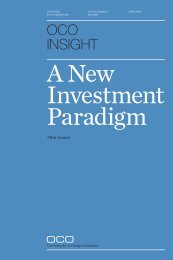PDF: Jones Lang LaSalle: Industrial Revolution Turns Green - Area ...
PDF: Jones Lang LaSalle: Industrial Revolution Turns Green - Area ...
PDF: Jones Lang LaSalle: Industrial Revolution Turns Green - Area ...
- No tags were found...
Create successful ePaper yourself
Turn your PDF publications into a flip-book with our unique Google optimized e-Paper software.
<strong>Industrial</strong> revolution turns green • 2U.S. Energy consumption, by end-useTransportation 29% Residential 21% Commercial 18% <strong>Industrial</strong> 32%ChemicalsHeatingLightingPetroleum refining50%10%40%GasolineDieselJet fuelOtherAir conditioningWater heatingLightingElectronicsRefrigerationDishwshr/laudryOtherAir conditioningHeatingElectronicsVentilationWater heatingRefrigerationOtherPrimary metalsPaperFood processingOther manufacturingNon-manufacturingFeedstocksFuel Source:Primarily petroleumPrimarily natural gasMix: natural gas, coal, nuclear, hydroelectric, renewablesSeveral low or no-cost measures can be implemented quicklyfor immediate gains. Facility operating expenses can instantlybe cut by a cumulative fi ve to 10 percent by adopting simplemeasures such as switching off lights when not in use, adjustingthermostats, turning off computers and offi ce equipment afterhours, and scheduling cleaning crews during daylight hours.Beyond buildings: Cost-effective strategiesToday we need to deploy industrial-strength green strategies thatgo beyond replacing ineffi cient light fi xtures and recycling waste,rethinking every aspect of facilities and operations with an eye onsustainability. Developing a comprehensive, innovative and costeffectivesustainability strategy with a long-term budget forecastdemonstrates the erroneous perception that sustainable buildingsmust cost more. Innovative approaches may include:• Performance contractsRather than spend capital to implement sustainable technologies,self-fund your improvements through performance contracts.Under such contracts, an energy service company or other serviceprovider commits to deliver an annual amount of cost savingson energy and operations when it makes mechanical, electrical,lighting, and building improvements. For the period of the contract—usually fi ve to 10 years—the money saved on operations andenergy can be used to cover the capital costs.• Government incentivesAs industrial properties’ energy expenditures grow, thegovernment is providing more incentives to help stimulate energyeffi ciency projects in industrial facilities. This year, companies fromCaterpillar to Dow Chemical pushed Congress to enact tax creditsfor industrial energy effi ciency projects. Both houses of Congressare currently weighing revisions to tax credits.Many municipalities offer rebates on a case-by-case basis forcommercial and industrial lighting, as well as industrial processupgrades, including premium effi ciency motors, motor controllersand adjustable speed drives, pumps, compressed air systems,refrigeration and dryers. For your state’s incentive policies andprograms, visit www.dsireusa.org.Whirlpool<strong>Jones</strong> <strong>Lang</strong> <strong>LaSalle</strong>’s Atlanta team recently achieved the goal ofLEED® certifi cation for a new, 1.5 million SF regional distributioncenter for Whirlpool in McDonough, GA. Providing projectmanagement and sustainability services, within three years wesuccessfully delivered the project, ahead of schedule and underbudget. The facility exceeded the LEED certifi cation goal, earningGold certifi cation—the largest industrial buildingin the U.S. to qualify for LEED at the Gold level.







